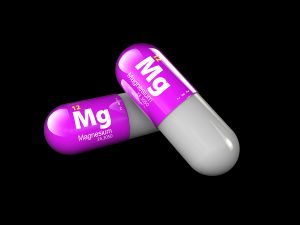In the following I am discussing the non-drug treatment for migraines in women. There are a number of different types of headaches: common headaches, tension type headaches, cluster headaches and migraine headaches. Here I am only zeroing in on migraine headaches.
Introduction
A migraine headache is the second most common headache and occurs with an average frequency of about 12% in the general population. Women outnumber men in the U.S. by a factor of 3 to 1 with migraines. There is a genetic factor as migraine sufferers’ family members are getting migraines about 3-fold more often than the general public. Newer insights into hormonal connections point to the fact that often migraine sufferers are in an estrogen dominant state (Ref. 4). With estrogen dominance there is a disbalance between estrogen production and progesterone production. For instance, many women who develop fibroids miss their ovulation and as a result can have fertility problems (no corpus luteum developed in the ovaries). The reason for infertility, fibroid development and the development of migraines in some migraine sufferers is the lack of progesterone in the second half of the cycle.
Xenoestrogens
Xenoestrogens (pesticides, artificial hormones like Provera, the birth control pill etc.) can also function as a contributor to the estrogen load as a woman’s estrogen receptors will have a partial fit with them. The resulting hormone disbalance can trigger migraines in migraine sufferers. The trigger is the relative lack of natural progesterone. This may also be the reason why migraines are much more common in woman than men. On the other hand Dr. S.A. Dugan has done hormone studies on both male and female patients with migraine. He found that both sexes are often also suffering from fibromyalgia, chronic fatigue syndrome, and lipid disorders including high cholesterol, sleep disorders, gastrointestinal problems and depression. When these patients had hormone tests were done on these patients the majority had what Dr. Dzugan called “steroidopenia” (low levels of estrogen, progesterone, testosterone and DHEA). This is discussed in more detail under Ref. 3.
Symptoms
Migraines present in 85% without an aura (formerly called “common migraines”) and in 15% with an aura (formerly called “classic migraines”). An aura consists of changed behaviors such as pacing, yawning, craving of certain foods, lethargy, depression or mild euphoria. These symptoms are separate from the migraine aura, which consists of neurological symptoms such as visual symptoms arise 1 or 2 hours before the migraine headache starts and disappear about 1 hour after the start of the migraine.
Types of migraine aura symptoms
These migraine aura symptoms are quite varied and can include numbness of the skin in a hand or a foot on the side where the migraine is and around the mouth area. Spotty eye field defects can also occur immediately prior to the onset of the headache and there may be deficits in language expression and pronunciation. Other such migraine aura symptoms can consist of double vision, ringing in the ears, balance problems, a gait abnormality and decreased levels of consciousness.
Typically a migraine is confined to one side of the head
The actual migraine headache is on one side of the head, can last 4 hours to 3 days, is throbbing in nature, moderately to severe in intensity and is made worse by physical activity, light or noise. The patient is complaining of nausea and might be vomiting with a severe migraine. In a small percentage of patients a more severe form of complicated migraine (or “migraine with prolonged aura”) can develop where the patient has prolonged symptoms of a migraine aura for more than 1 hour, but usually less than 1 week. These patients should be investigated thoroughly by a neurologist as a small percentage of these patients can develop persistent neurological symptoms including a “migraine stroke ” (=a stroke like clinical picture) (Ref. 1, p. 2067).
Conventional treatment of migraines
Medication that is used is quite different between attacks as compared to during an attack. During a migraine attack non-steroidal anti-inflammatory drugs (=NSAIDs) and dihydroergotamine or Sumatriptan, which stimulate serotonin receptors, are common medications. Drug dependency issues on narcotics have to be discussed frankly with the patient because of the danger of rebound migraines that are triggered by the continued use of narcotics. Sumatriptan can be given intranasally, but it is important for the physician to monitor overuse and dependency on this medication. In males there is a higher risk for heart attacks as a side effect of the medication. The patient can also receive Prochlorperazine (brand name: Stemetil or Compro) intravenously as a drip in an Emergency room setting. This can abort a migraine.
Preventatives of migraine attacks
Between migraine attacks there are a number of preventatives that are effective. They consist of beta-blockers such as propranolol, metoprolol, Timolol and others; NSAIDs such as ASA, naproxen or ketoprofen; calcium channel blockers such as Verapamil or Flunarizine, also antidepressants such as amitriptyline.
Gabapentin is the latest medication that research found to be useful in several smaller studies. Gabapentin (brand name: Neurontin) releases GABA in some parts of the brain and inhibits the NMDA pain receptors. Dr. Stephen Clarke, Clinical Assistant Professor in the Div. of Neurology of the University of BC/Vancouver/Canada, reviewed the use of gabapentin at a conference in Vancouver/BC in November 2004 (Ref. 2).
Other medication for headache prevention are the anticonvulsant gabapentin; the MAO inhibitor phenelzine and the serotonin stimulating drugs methysergide and cyproheptadine. Unfortunately many of these medications do not work 100% and there is a lack of good randomized studies to prove effectiveness.
Non-conventional, but effective treatment of migraines
Bioidentical progesterone treatment
In light of what I explained above with regard to a hormone disbalance in women migraine sufferers, it is logical that Dr. Lee suggested (Ref. 5) using 20 mg of a bioidentical progesterone cream applied to the skin during the second half of the cycle (day 12 to 26 of the cycle). After three months there is usually a significant improvement of the migraines. With only a partial response to this low dose of progesterone cream, the doctor can increase the progesterone dosage temporarily to 40 or 50 mg per day from day 12 to 26 of the cycle for several months. If there is a response, the doctor continues treatments with bioidentical progesterone cream until menopause. An alternative to bio-identical progesterone cream is Prometrium (micronized progesterone) by mouth, 100mg or 200mg at bedtime. Discuss this with your doctor. You will need a prescription from him/her for Prometrium.
Avoid migraine triggering factors
It is important to include in the regimen of anti-migraine measures non drug regimens such as avoidance of triggering factors like certain foods (chocolate, red wine, certain cheeses and strong smells) or bright lights and noises. It is important to pay attention to consistent sleeping patterns and meal times. When emotional factors play a role, counseling, relaxation techniques like yoga, self-hypnosis and biofeedback methods are all helpful as well. The doctor refers more complex migraine cases to a neurologist or a multidisciplinary headache clinic.
Dr. Dzugan’s “correction of steroidopenia” approach
Since Dr. Dzugan published the results of treating migraine sufferers with the Dzugan method, it is important to look at all of the hormones including steroid hormones as mentioned above. Any hormone deficiency is rectified using bio-identical hormones; then the doctor repeats hormone levels to verify hormone balance. Dr. Dzugan found that following “correction of steroidopenia” after 9 to 12 months at the latest almost all of his patients were migraine free and lost all of the other accompanying symptoms.
Conclusion
Many women suffer needlessly from migraines because of estrogen dominance. Estrogen dominance occurs when they miss an ovulation (because of a lack of the corpus luteum that manufactures progesterone in the second part of the menstrual cycle). But taking the birth control pill or taking HRT with synthetic hormones in menopause can also cause estrogen dominance. This is when bioidentical progesterone replacement can help to rebalance progesterone and estrogen. Migraines often disappear in the process of this approach. If you have migraines, you should discuss the bioidentical progesterone approach with your doctor.
References
- Goldman: Cecil Textbook of Medicine, 21st ed.,2000, W. B. Saunders Company
- The 50th Annual St. Paul’s Hospital Continuing Medical Education Conference for Primary Physicians, Nov. 16 – 19, 2004, Vancouver,BC, Canada
- http://www.ncbi.nlm.nih.gov/pubm…: Dzugan SA, Rozakis GW, Dzugan KS, Emhof L, Dzugan SS, Xydas C, Michaelides C, Chene J, Medvedovsky M.: “Correction of steroidopenia as a new method of hypercholesterolemia treatment.” Neuro Endocrinol Lett. 2011;32(1):77-81.
- Dr. John R. Lee, David Zava and Virginia Hopkins: “What your doctor may not tell you about breast cancer – How hormone balance can help save your life”, Wellness Central, Hachette Book Group USA, 2005. On page 256 and 257 Dr. Lee describes how he uses progesterone as a cream to treat PMS.
- Dr. John R. Lee: “Natural Progesterone- The remarkable roles of a remarkable hormone”, Jon Carpenter Publishing, 2nd edition, 1999, Bristol, England.









